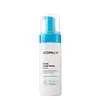What's inside
What's inside
 Key Ingredients
Key Ingredients

 Benefits
Benefits

 Concerns
Concerns

 Ingredients Side-by-side
Ingredients Side-by-side

Water
Skin ConditioningSorbitol
HumectantLauryl Hydroxysultaine
CleansingGlycerin
HumectantPotassium Cocoyl Glutamate
Coco-Glucoside
CleansingBetaine
HumectantSodium Chloride
Masking1,2-Hexanediol
Skin ConditioningSodium Cocoyl Isethionate
CleansingHydroxyacetophenone
AntioxidantPanthenol
Skin ConditioningPimpinella Anisum Fruit Extract
MaskingSodium Phytate
Sodium PCA
HumectantVanilla Planifolia Fruit Extract
Skin ConditioningPrunus Armeniaca Fruit Extract
Skin ConditioningViola Odorata Leaf Extract
MaskingPrunus Amygdalus Amara Kernel Oil
MaskingTocopherol
AntioxidantPalmitoyl Palmitamide Mea
HumectantBis-Capryloyloxypalmitamido Isopropanol
EmollientN-Linolenoyl Serinol
Skin ConditioningLeucine
Skin ConditioningLysine
Skin ConditioningPhenylalanine
MaskingThreonine
Valine
MaskingWater, Sorbitol, Lauryl Hydroxysultaine, Glycerin, Potassium Cocoyl Glutamate, Coco-Glucoside, Betaine, Sodium Chloride, 1,2-Hexanediol, Sodium Cocoyl Isethionate, Hydroxyacetophenone, Panthenol, Pimpinella Anisum Fruit Extract, Sodium Phytate, Sodium PCA, Vanilla Planifolia Fruit Extract, Prunus Armeniaca Fruit Extract, Viola Odorata Leaf Extract, Prunus Amygdalus Amara Kernel Oil, Tocopherol, Palmitoyl Palmitamide Mea, Bis-Capryloyloxypalmitamido Isopropanol, N-Linolenoyl Serinol, Leucine, Lysine, Phenylalanine, Threonine, Valine
Morinda Citrifolia Extract 35.511%
AstringentWater
Skin ConditioningCocamidopropyl Betaine
CleansingButylene Glycol
HumectantGlycerin
HumectantPotassium Cocoyl Glycinate
Lauramide DEA
Sodium Chloride
MaskingDisodium Cocoamphodiacetate
CleansingSodium Cocoyl Glutamate
CleansingPanthenol
Skin Conditioning1,2-Hexanediol
Skin ConditioningMethylpropanediol
SolventAllantoin
Skin ConditioningSalicylic Acid
MaskingCaprylyl Glycol
EmollientSodium Benzoate
MaskingDipotassium Glycyrrhizate
HumectantRosmarinus Officinalis Leaf Oil
MaskingSalix Alba Bark Extract
AstringentCamellia Sinensis Leaf Extract
AntimicrobialCentella Asiatica Leaf Extract
Skin ConditioningCladosiphon Okamuranus Extract
Skin ConditioningDecyl Glucoside
CleansingButeth-3
SolventPiroctone Olamine
PreservativeDisodium EDTA
Citric Acid
BufferingMelia Azadirachta Leaf Extract
Skin ConditioningCoffea Arabica Seed Extract
MaskingSodium Benzotriazolyl Butylphenol Sulfonate
UV AbsorberMelia Azadirachta Flower Extract
Skin ConditioningPrunus Mume Fruit Extract
HumectantLonicera Japonica Flower Extract
Skin ConditioningScutellaria Baicalensis Root Extract
AstringentCitrus Aurantium Bergamia Leaf Extract
AstringentPinus Densiflora Leaf Extract
AntimicrobialTributyl Citrate
SolventTheobroma Cacao Extract
Skin ConditioningDextrin
AbsorbentPinus Palustris Leaf Extract
TonicUlmus Davidiana Root Extract
Skin ConditioningOenothera Biennis Flower Extract
AstringentPueraria Lobata Root Extract
HumectantMorinda Citrifolia Extract 35.511%, Water, Cocamidopropyl Betaine, Butylene Glycol, Glycerin, Potassium Cocoyl Glycinate, Lauramide DEA, Sodium Chloride, Disodium Cocoamphodiacetate, Sodium Cocoyl Glutamate, Panthenol, 1,2-Hexanediol, Methylpropanediol, Allantoin, Salicylic Acid, Caprylyl Glycol, Sodium Benzoate, Dipotassium Glycyrrhizate, Rosmarinus Officinalis Leaf Oil, Salix Alba Bark Extract, Camellia Sinensis Leaf Extract, Centella Asiatica Leaf Extract, Cladosiphon Okamuranus Extract, Decyl Glucoside, Buteth-3, Piroctone Olamine, Disodium EDTA, Citric Acid, Melia Azadirachta Leaf Extract, Coffea Arabica Seed Extract, Sodium Benzotriazolyl Butylphenol Sulfonate, Melia Azadirachta Flower Extract, Prunus Mume Fruit Extract, Lonicera Japonica Flower Extract, Scutellaria Baicalensis Root Extract, Citrus Aurantium Bergamia Leaf Extract, Pinus Densiflora Leaf Extract, Tributyl Citrate, Theobroma Cacao Extract, Dextrin, Pinus Palustris Leaf Extract, Ulmus Davidiana Root Extract, Oenothera Biennis Flower Extract, Pueraria Lobata Root Extract
 Reviews
Reviews

Ingredients Explained
These ingredients are found in both products.
Ingredients higher up in an ingredient list are typically present in a larger amount.
1,2-Hexanediol is a synthetic liquid and another multi-functional powerhouse.
It is a:
- Humectant, drawing moisture into the skin
- Emollient, helping to soften skin
- Solvent, dispersing and stabilizing formulas
- Preservative booster, enhancing the antimicrobial activity of other preservatives
Glycerin is already naturally found in your skin. It helps moisturize and protect your skin.
A study from 2016 found glycerin to be more effective as a humectant than AHAs and hyaluronic acid.
As a humectant, it helps the skin stay hydrated by pulling moisture to your skin. The low molecular weight of glycerin allows it to pull moisture into the deeper layers of your skin.
Hydrated skin improves your skin barrier; Your skin barrier helps protect against irritants and bacteria.
Glycerin has also been found to have antimicrobial and antiviral properties. Due to these properties, glycerin is often used in wound and burn treatments.
In cosmetics, glycerin is usually derived from plants such as soybean or palm. However, it can also be sourced from animals, such as tallow or animal fat.
This ingredient is organic, colorless, odorless, and non-toxic.
Glycerin is the name for this ingredient in American English. British English uses Glycerol/Glycerine.
Learn more about GlycerinPanthenol is a common ingredient that helps hydrate and soothe the skin. It is found naturally in our skin and hair.
There are two forms of panthenol: D and L.
D-panthenol is also known as dexpanthenol. Most cosmetics use dexpanthenol or a mixture of D and L-panthenol.
Panthenol is famous due to its ability to go deeper into the skin's layers. Using this ingredient has numerous pros (and no cons):
Like hyaluronic acid, panthenol is a humectant. Humectants are able to bind and hold large amounts of water to keep skin hydrated.
This ingredient works well for wound healing. It works by increasing tissue in the wound and helps close open wounds.
Once oxidized, panthenol converts to pantothenic acid. Panthothenic acid is found in all living cells.
This ingredient is also referred to as pro-vitamin B5.
Learn more about PanthenolChances are, you eat sodium chloride every day. Sodium Chloride is also known as table salt.
This ingredient has many purposes in skincare: thickener, emulsifier, and exfoliator.
You'll most likely find this ingredient in cleansers where it is used to create a gel-like texture. As an emulsifier, it also prevents ingredients from separating.
There is much debate on whether this ingredient is comedogenic. The short answer - comedogenic ratings don't tell the whole story. Learn more about comegodenic ratings here.
The concensus about this ingredient causing acne seems to be divided. Research is needed to understand if this ingredient does cause acne.
Scrubs may use salt as the primary exfoliating ingredient.
Learn more about Sodium ChlorideWater. It's the most common cosmetic ingredient of all. You'll usually see it at the top of ingredient lists, meaning that it makes up the largest part of the product.
So why is it so popular? Water most often acts as a solvent - this means that it helps dissolve other ingredients into the formulation.
You'll also recognize water as that liquid we all need to stay alive. If you see this, drink a glass of water. Stay hydrated!
Learn more about Water